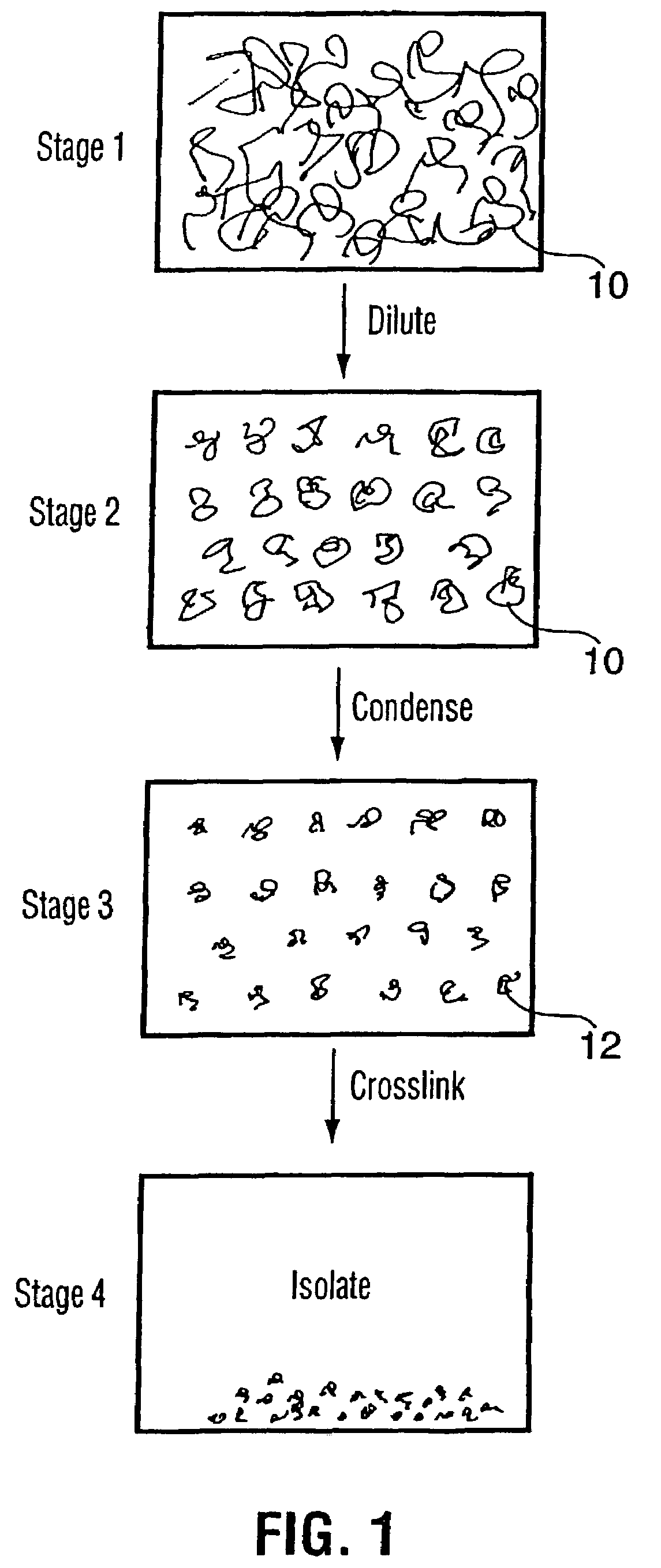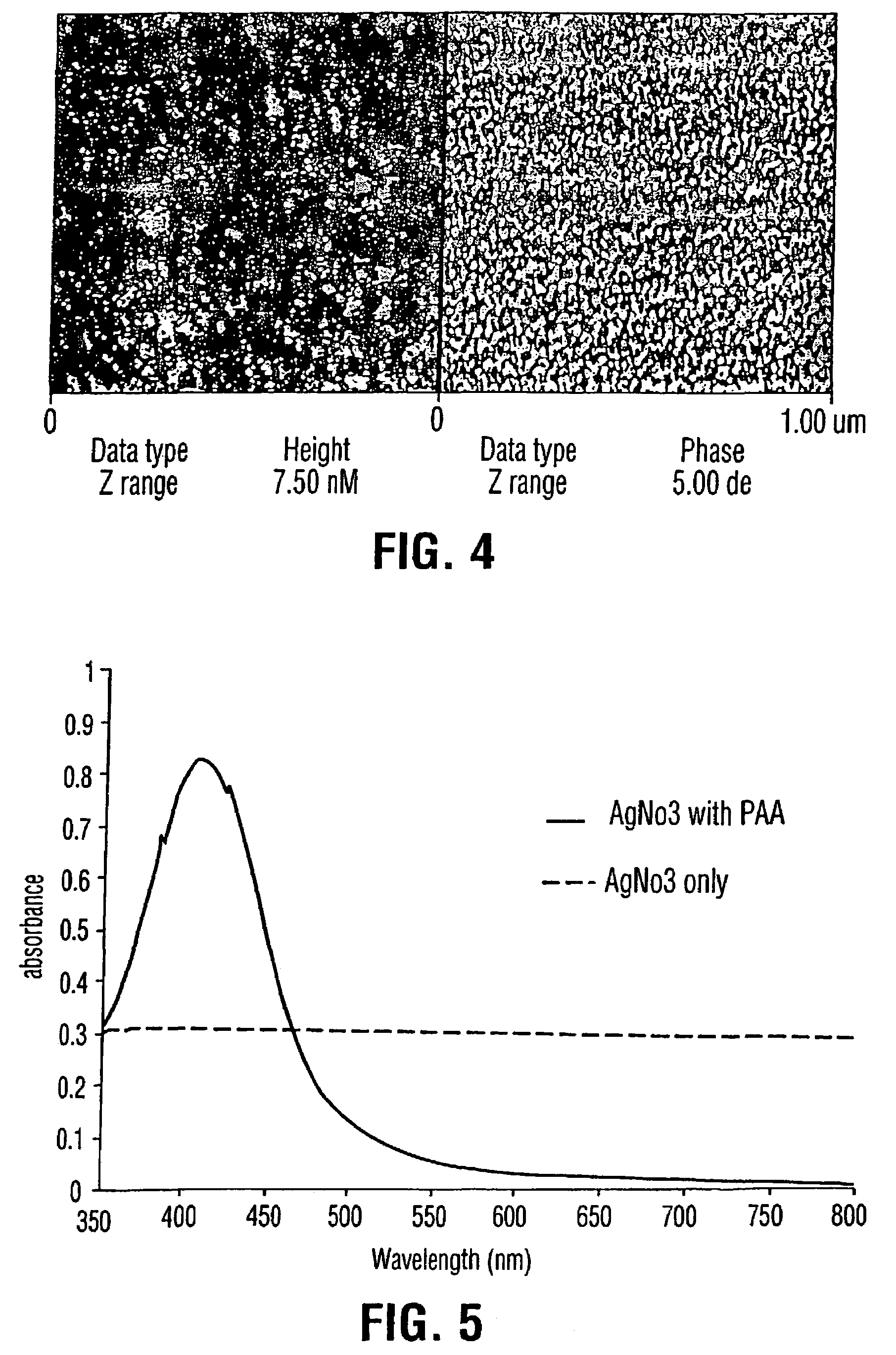Cross-linked polymeric nanoparticles and metal nanoparticles derived therefrom
a technology of metal nanoparticles and polymeric nanoparticles, which is applied in the field of polymerization, can solve the problems of limited control over its course and exten
- Summary
- Abstract
- Description
- Claims
- Application Information
AI Technical Summary
Benefits of technology
Problems solved by technology
Method used
Image
Examples
example 1
Internally Cross-Linked Polyacrylic Acid
[0035]The sodium salt of poly(acrylic) acid (Polysciences Inc. Cat #18755), of molecular weight of 1,300,000, was used in a cross-linking process according to the invention. 97 mg of polymer was dissolved in 100 ml of distilled water. After solution was complete the pH was 8.2, and 98 mg of sodium chloride was slowly added to cause the polymer particles to contract. 5 cc. of the solution was flushed with nitrogen, sealed in a glass vial, and irradiated with 10 megarad of Co60 γ radiation. After radiation the vial was opened and the solution dialysed against water for 5 days to remove the salt, and the polymer particles recovered by freeze drying under vacuum. The particles were studied by atomic force microscopy (A.F.M) (film cast onto mica, to produce tapping mode AFM height image) and shown to be perfectly spherical, with diameters of 6 to 10 nanometers (see FIG. 2). No such particles were observed in the uncross-linked control sample. The p...
example 2
[0037]The procedure of Example 1 was repeated except that before addition of the sodium chloride the pH of the solution was reduced to 3.2 by addition of small amounts of 0.1 N hydrochloric acid. After addition of sodium chloride and cross-linking with 10 megarad of γ-rays, nanoparticles of the same size (6–10 nanometers) were observed as in Example 1 by A.F.M.
example 3
[0038]Copolymers of sodium styrene sulfonate and vinyl naphthalene containing about equal quantities of each comonomer are known to form hypercoiled pseudomicellar conformations in water, i.e. they do not form expanded random coils, but are collapsed into much smaller spherical structures with much higher coil density due to the hydrophobic interactions between the naphthalene groups and water. These particles are negatively charged due to the ionization of the styrene sulfonate groups in water. The polymers can also be internally cross-linked by the following procedure. A polymer containing 50% by weight sodium styrene sulfonate and 50% of vinyl naphthalene was prepared in benzene solution AIBN as catalyst. After isolation and purification by dialysis against pure water it had a molecular weight Mw of 200,000.
[0039]100 mg of this polymer was dissolved in 100 ml distilled water and after purging with oxygen-free nitrogen was irradiated with a dose of 0.40 megarad of Cobalt60 γ-rays....
PUM
| Property | Measurement | Unit |
|---|---|---|
| size | aaaaa | aaaaa |
| diameter | aaaaa | aaaaa |
| diameters | aaaaa | aaaaa |
Abstract
Description
Claims
Application Information
 Login to View More
Login to View More - R&D
- Intellectual Property
- Life Sciences
- Materials
- Tech Scout
- Unparalleled Data Quality
- Higher Quality Content
- 60% Fewer Hallucinations
Browse by: Latest US Patents, China's latest patents, Technical Efficacy Thesaurus, Application Domain, Technology Topic, Popular Technical Reports.
© 2025 PatSnap. All rights reserved.Legal|Privacy policy|Modern Slavery Act Transparency Statement|Sitemap|About US| Contact US: help@patsnap.com



